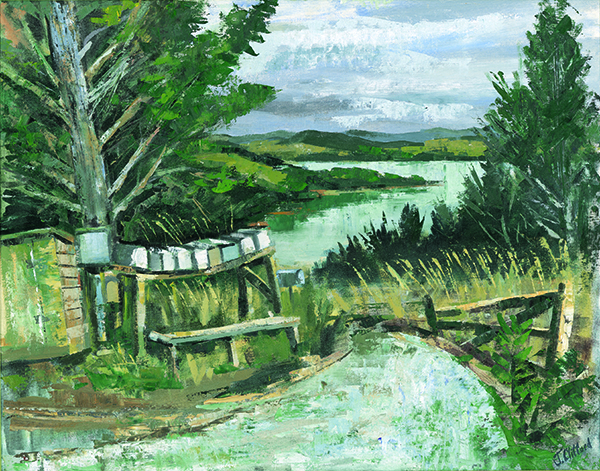Fairburn and his Mahurangi friends in the wilderness

End of the Road: This scene was painted at the end of Mahurangi West Road, prior to the subdivision of Jamieson Bay and Ōpahi. The work belonged to Birgit Hellstrom who lived adjacent from where it was painted, until she moved into aged care, in Picton. artist John Clifford
And up to Mahurangi—always to Mahurangi…
Not only was Mahurangi the charismatic ‘ARD’ Fairburn’s special place, it was also that for a good number of the 29 exceptionally talented friends featured in the anthology Fairburn and Friends including the four who lived there: publisher, Terry Bond; artist, Eric Lee-Johnson; Mahurangi Actionthen: Friends of the Mahurangi founding chairman, John Male; and champion of the Mahurangi River, Claude Thompson.
Terry Bond and Rex Fairburn formed a close relationship returning home on the Rangitikei after two years in England that had left the latter decidedly anti-English. Bond, on his next and final trip to London shipped back a small keel boat and dinghy. He then proceeded to scout, from the water, a site for his future Arcadia. He introduced himself to Fred Jackson who said that while his Huawai Bay property was not for sale, the neighbouring twenty acres were.
From that time on, it was ‘up to Mahurangi; always to Mahurangi’ Rex Fairburn’s wife Jocelyn is elsewhere quoted as saying—on his own, in the single-cylinder 12ft clinker dinghy he’d built himself, stretched out on a mattress under the stars, steering with his feet; on his own, hitchhiking and walking on his feetWalking On My Feet: A R D Fairburn, 1904–1957 : A Kind of Biography. Bond would wake to find Fairburn asleep on his sofa, having arrived late at night. But also with his family, Rex transporting Jocelyn and their four appreciative and ‘uncommonly fortunate’ children in a hired truck for six-week-long camping holidays in ‘WaikatoŌpahi, and originally Ōpahi, not Ōpahi Bay’ Bay.
Fairburn’s finest work To a Friend in the Wilderness, is believed to refer to Bond’s ‘cavernous rock’ of a house on a Mahurangi summer’s day, but the poem’s dedication to another who couldn’t desert his town-based people, Douglas Robb, has caused confusion. Meantime Ron Locker, in Jade River : A History of the Mahurangi stops just short of stating that another of Rex’s poems, The Estuary, refers to the Mahurangi. I don’t see that it can, particularly the dunes of the last lines:
Give me the ghost of your hand:
unreal, unreal the dunes
the sea, the mangroves, and the moon’s white light
unreal, beneath our naked feet, the sand.
To my all-too-literal mind, this sings of the sweet little Te Muri Estuary; but the inspiration could be from even farther afield.
I gladly gave Fairburn and Friends a plug, sight unseen, in the January 2005 Mahurangi Bulletin. Subsequently, having the anthology to hand to read on the day after the regatta was a treat. The blurb’s promise of ‘affectionate portraits but not uncritical’ of Fairburn and his friends is fulfilled. Thrice-married John Male’s facetious declaration to Rex—in respect to the ex holiday camp for orphans which Rex had lined up for Male’s purchase—that he was planning to ‘found a cult, consisting of me and 18 virgins of the sun’ hints at a shared, all-too-male outlook that was something of a trial for their respective spouses. Birgit Helstrom, who lived in the house originally built by Terry Bond for his mother, told me that when Rex visited she went to bed—knowing that her husband ‘Yon’ (John) and Rex would be talking and drinking most of the night. But Bi was very fond of Fairburn; she was very widely read and was delighted with the McNeishs’ Walking On My Feet: A.R.D. Fairburn, 1904-1957 : A Kind of Biography (unauthorised and deeply unpopular with the Fairburn family).
The book’s squalid tea is strained by the lack of a bibliography or index, copy-and-paste mishaps and by less than professional typography. These deficiencies are more than forgivable given the labour of love nature of the publication—but ironic given some friends’ high regard for elegant typography (particularly, the pernickety printers Dennis Glover and Robert Lowry). Don’t be put off though, just don’t be alarmed to find you are reading the same sentence twice; you probably are. (If Fairburn and Friends goes to a second edition, I hereby volunteer my services, particularly to address the lack of an index.)
So very well done to our Beverley Simmons (of ‘Riverina’, Warkworth) and the other 21 authors and editors; the ebullient spirit of Arthur Rex Dugard Fairburn burns more brilliant, including in the Mahurangi, as a result of your affectionate writing. It also shamed me into belatedly reading Denys Trussell’s masterly and definitive Fairburn. Definitive, except that is for the want of a companion Complete Works of A R D Fairburn to consult for the full text of the poems quoted.
Squalid Tea Apologies to Fairburn’s famous steam-age pun: ‘the squalid tea of Mercer is not strained’.
Further reading particularly for its Mahurangi content, No Road to Follow: Autobiography of a New Zealand Artist (Eric Lee-Johnson, Godwit Press Limited, 1994)
